Modification Effects of Population Expansion, Ageing, and Adaptation on Heat-Related Mortality Risks Under Different Climate Change Scenarios in Guangzhou, China
Abstract
1. Introduction
2. Materials and Methods
2.1. Study Settings
2.2. Data Collection and Preparation
2.3. Heat Effects Estimation
2.4. Projection of Future Heat Effects
3. Results
3.1. General Characteristics
3.2. Independent Effects of Temperature Increase on Heat-Related Ylls in the 2030s, 2060s, and 2090s
3.3. Modification of Population Expansion and Adaptation on Heat-Related YLLs in the 2030s, 2060s, and 2090s
3.4. Modification of Population Ageing and Adaptation on Heat-Related YLLs in the 2030s, 2060s, and 2090s
4. Discussion
Limitations and Uncertainties
5. Conclusions
Supplementary Materials
Author Contributions
Funding
Acknowledgments
Conflicts of Interest
References
- Stocker, T.F.; Qin, D.; Plattner, G.-K.; Tignor, M.; Allen, S.K.; Boschung, J.; Nauels, A.; Xia, Y.; Bex, V.; Midgley, P.M. IPCC, 2013: Climate Change 2013: The Physical Science Basis; Contribution of Working Group I to the Fifth Assessment Report of the Intergovernmental Panel on Climate Change; Cambridge University Press: Cambridge, UK; New York, NY, USA, 2013. [Google Scholar]
- Guo, Y.; Gasparrini, A.; Armstrong, B.; Li, S.; Tawatsupa, B.; Tobias, A.; Lavigne, E.; de Sousa Zanotti Stagliorio Coelho, M.; Leone, M.; Pan, X.; et al. Global Variation in the Effects of Ambient Temperature on Mortality: A Systematic Evaluation. Epidemiology 2014, 25, 781–789. [Google Scholar] [CrossRef] [PubMed]
- Phung, D.; Thai, P.K.; Guo, Y.; Morawska, L.; Rutherford, S.; Chu, C. Ambient temperature and risk of cardiovascular hospitalization: An updated systematic review and meta-analysis. Sci. Total Environ. 2016, 550, 1084–1102. [Google Scholar] [CrossRef] [PubMed]
- Huang, C.; Barnett, A.G.; Wang, X.; Vaneckova, P.; FitzGerald, G.; Tong, S. Projecting future heat-related mortality under climate change scenarios: A systematic review. Environ. Health Perspect. 2011, 119, 1681–1690. [Google Scholar] [CrossRef] [PubMed]
- Gosling, S.N.; Lowe, J.A.; McGregor, G.R.; Pelling, M.; Malamud, B.D. Associations between elevated atmospheric temperature and human mortality: A critical review of the literature. Clim. Chang. 2009, 92, 299–341. [Google Scholar] [CrossRef]
- Li, T.; Horton, R.M.; Bader, D.A.; Zhou, M.; Liang, X.; Ban, J.; Sun, Q.; Kinney, P.L. Aging will amplify the heat-related mortality risk under a changing climate: Projection for the elderly in Beijing, China. Sci. Rep. 2016, 6, 28161. [Google Scholar] [CrossRef]
- Petkova, E.P.; Vink, J.K.; Horton, R.M.; Gasparrini, A.; Bader, D.A.; Francis, J.D.; Kinney, P.L. Towards more comprehensive projections of urban heat-related mortality: Estimates for New York City under multiple population, adaptation, and climate scenarios. Environ. Health Perspect. 2016, 125, 47–55. [Google Scholar] [CrossRef]
- Li, X.; Song, J.; Lin, T.; Dixon, J.; Zhang, G.; Ye, H. Urbanization and health in China, thinking at the national, local and individual levels. Environ. Health 2016, 15 (Suppl. 1), 32. [Google Scholar] [CrossRef]
- Lee, J.Y.; Kim, H. Projection of future temperature-related mortality due to climate and demographic changes. Environ. Int. 2016, 94, 489–494. [Google Scholar] [CrossRef]
- Zhang, B.; Li, G.; Ma, Y.; Pan, X. Projection of temperature-related mortality due to cardiovascular disease in beijing under different climate change, population, and adaptation scenarios. Environ. Res. 2018, 162, 152–159. [Google Scholar] [CrossRef]
- Wu, W.; Xiao, Y.; Li, G.; Zeng, W.; Lin, H.; Rutherford, S.; Xu, Y.; Luo, Y.; Xu, X.; Chu, C.; et al. Temperature-mortality relationship in four subtropical Chinese cities: A time-series study using a distributed lag non-linear model. Sci. Total Environ. 2013, 449, 355–362. [Google Scholar] [CrossRef]
- Zeng, W.; Lao, X.; Shannon, R.; Xu, Y.; Xu, X.; Lin, H.; Liu, T.; Luo, Y.; Xiao, J.; Hu, M.; et al. The effect of heat waves on mortality and effect modifiers in four communities of Guangdong Province, China. Sci. Total Environ. 2014, 482–483, 214–221. [Google Scholar] [CrossRef] [PubMed]
- Hajat, S.; O’Connor, M.; Kosatsky, T. Health effects of hot weather: From awareness of risk factors to effective health protection. Lancet 2010, 375, 856–863. [Google Scholar] [CrossRef]
- Vardoulakis, S.; Dear, K.; Hajat, S.; Heaviside, C.; Eggen, B. Comparative assessment of the effects of climate change on heat- and cold-related mortality in the United Kingdom and Australia. Environ. Health Perspect. 2014, 122, 1285–1292. [Google Scholar] [CrossRef]
- Hondula, D.M.; Balling, R.C.; Vanos, J.K.; Georgescu, M. Rising Temperatures, Human Health, and the Role of Adaptation. Curr. Clim. Chang. Rep. 2015, 1, 144–154. [Google Scholar] [CrossRef]
- Guangzhou Statistics Department. The Gender and Age Structure of Population in Guangzhou: Data from the Sixth National Census 2013. Available online: http://www.gzstats.gov.cn/pchb/rkpc6/t1-07.htm (accessed on 19 February 2017).
- Lin, P. Analysis on the Climate Characteristic and Climatic Change in Guangzhou City in Last 50 Years. J. Liaocheng Univ. 2007, 3, 81–84. [Google Scholar]
- World Health Organization. Global Health Observatory Data Repository: Life Tables by Country, China. Available online: http://apps.who.int/gho/data/?theme=main&vid=60340 (accessed on 15 September 2013).
- Li, T.; Ban, J.; Horton, R.M.; Bader, D.A.; Huang, G.; Sun, Q.; Kinney, P.L. Heat-related mortality projections for cardiovascular and respiratory disease under the changing climate in Beijing, China. Sci. Rep. 2015, 5, 11441. [Google Scholar] [CrossRef] [PubMed]
- Li, T.; Horton, R.M.; Kinney, P.L. Projections of seasonal patterns in temperature-related deaths for Manhattan, New York. Nat. Clim. Chang. 2013, 3, 717–721. [Google Scholar] [CrossRef] [PubMed]
- Bureau of Reclamation. Downscaled CMIP3 and CMIP5 Climate and Hydrology Projections: Release of Downscaled CMIP5 Climate Projections, Comparison with Preceding Information, and Summary of User Needs; U.S. Department of the Interior, Bureau of Reclamation, Technical Services Center: Denver, CO, USA, 2013. Available online: http://apps.who.int/gho/data/?theme=main&vid=60340 (accessed on 3 January 2019).
- Schmidli, J.; Frei, C.; Vidale, P.L. Downscaling from GCM precipitation: A benchmark for dynamical and statistical downscaling methods. Int. J. Climatol. 2006, 26, 679–689. [Google Scholar] [CrossRef]
- Marsh, C.; Barwell, L.; Gavish, Y.; Kunin, W. Downscale: An R package for downscaling species occupancy from coarse-grain data to predict occupancy at fine-grain sizes. J. Stat. Softw. 2018, 86, 1–20. [Google Scholar] [CrossRef]
- Chinese Surface Stations for Global Exchange (V3.0). Available online: http://data.cma.cn/ (accessed on 1 August 2016).
- United Nations, Department of Economic and Social Affairs, Population Division. World Population Prospects: The 2015 Revision, Methodology of the United Nations Population Estimates and Projections; Working Paper No. ESA/P/WP.242; United Nations: New York, NY, USA, 2015. [Google Scholar]
- Raftery, A.E.; Li, N.; Ševčíková, H.; Gerland, P.; Heilig, G.K. Bayesian probabilistic population projections for all countries. Proc. Natl. Acad. Sci. USA 2012, 109, 13915–13921. [Google Scholar] [CrossRef]
- Song, S.; Shen, J.; Lin, G.; Dong, H.; Li, K.; Zhou, Q. Analysis of main causes of deaths and potential years of life lost among residents in Guangzhou City, 2011. South China. J. Prev. Med. 2013, 39, 15–19. [Google Scholar]
- Municipality, S.B. Guangzhou Statistical Yearbook. Available online: http://data.gzstats.gov.cn/gzStat1/chaxun/njsj.jsp (accessed on 22 April 2017).
- Lin, D.; Zeng, F. Analysis on the life expectancy in Guangzhou. J. Sun Yat-sen Univ. 1995, 35, 55–62. [Google Scholar]
- Yang, M.; Bi, Z.; Ren, C.; He, X.; Tang, N.; Lin, H.; Wen, Y.; Shi, S.; Wu, R. The Life Expectancy in Guangzhou Approachs 80 Years. Guangzhou Daily, 27 December 2011. [Google Scholar]
- Li, X. The Life Expectancy of People in Guangzhou Reaches 81.72 Years. Nanfang Daily, 15 March 2017. [Google Scholar]
- Raftery, A.E.; Chunn, J.L.; Gerland, P.; Ševčíková, H. Bayesian probabilistic projections of life expectancy for all countries. Demography 2013, 50, 777–801. [Google Scholar] [CrossRef] [PubMed]
- Leridon, H. Demography: Measuring and Modeling Population Processes. Population 2001, 57, 591. [Google Scholar]
- Field, C.B.; Barros, V.R.; Dokken, D.J.; Mach, K.J.; Mastrand rea, M.D.; Bilir, T.E.; Chatterjee, M.; Ebi, K.L.; Estrada, Y.O.; Genova, R.C.; et al. IPCC, 2014: Climate Change 2014: Impacts, Adaptation, and Vulnerability. Part A: Global and Sectoral Aspects; Contribution of Working Group II to the Fifth Assessment Report of the Intergovernmental Panel on Climate Change; Cambridge University Press: Cambridge, UK; New York, NY, USA, 2014. [Google Scholar]
- Yang, C.; Meng, X.; Chen, R.; Cai, J.; Zhao, Z.; Wan, Y.; Kan, H. Long-term variations in the association between ambient temperature and daily cardiovascular mortality in Shanghai, China. Sci. Total Environ. 2015, 538, 524–530. [Google Scholar] [CrossRef]
- Petkova, E.P.; Gasparrini, A.; Kinney, P.L. Heat and Mortality in New York City since the Beginning of the 20th Century. Epidemiology 2014, 25, 554–560. [Google Scholar] [CrossRef]
- Barrett, J.R. Increased minimum mortality temperature in France: Data suggest humans are adapting to climate change. Environ. Health Perspect. 2015, 123, A184. [Google Scholar] [CrossRef]
- Todd, N.; Valleron, A.-J. Space-time covariation of mortality with temperature: A systematic study of deaths in France, 1968–2009. Environ. Health Perspect. 2015, 123, 659–664. [Google Scholar] [CrossRef]
- Gasparrini, A.; Armstrong, B.; Kenward, M.G. Distributed lag non-linear models. Stat. Med. 2010, 29, 2224–2234. [Google Scholar] [CrossRef]
- Peng, R.D.; Dominici, F.; Louis, T.A. Model choice in time series studies of air pollution and mortality. J. R. Stat. Soc. Ser. A Stat. Soc. 2006, 169, 179–203. [Google Scholar] [CrossRef]
- Liu, T.; Zhang, Y.H.; Xu, Y.J.; Lin, H.L.; Xu, X.J.; Luo, Y.; Xiao, J.; Zeng, W.L.; Zhang, W.F.; Chu, C. The effects of dust–haze on mortality are modified by seasons and individual characteristics in Guangzhou, China. Environ. Pollut. 2014, 187, 116–123. [Google Scholar] [CrossRef] [PubMed]
- Liu, T.; Li, T.T.; Zhang, Y.H.; Xu, Y.J.; Lao, X.Q.; Rutherford, S.; Chu, C.; Luo, Y.; Zhu, Q.; Xu, X.J.; et al. The short-term effect of ambient ozone on mortality is modified by temperature in Guangzhou, China. Atmos. Environ. 2013, 76, 59–67. [Google Scholar] [CrossRef]
- Zeng, Y.; Hesketh, T. The effects of China’s universal two-child policy. Lancet 2016, 388, 1930–1938. [Google Scholar] [CrossRef]
- Zeng, Y.; Wang, Z. A Policy Analysis on Challenges and Opportunities of Population/Household Aging in China. J. Popul. Age 2014, 7, 255–281. [Google Scholar] [CrossRef]
- United Nations Human Settlements Programme. Cities and Climate Change: Global Report on Human Settlements 2011; Earthscan Ltd.: London, UK, 2011. [Google Scholar]
- Kovats, R.S.; Hajat, S. Heat Stress and Public Health: A Critical Review. Ann. Rev. Public Health 2008, 29, 41–55. [Google Scholar] [CrossRef] [PubMed]
- Jenkins, K.; Hall, J.W.; Glenis, V.; Kilsby, C.G.; Mccarthy, M.P.; Goodess, C.M.; Smith, D.; Malleson, N.; Birkin, M. Probabilistic spatial risk assessment of heat impacts and adaptations for London. Clim. Chang. 2014, 124, 105–117. [Google Scholar] [CrossRef]
- Matthies, F.; Bickler, G.; Marín, N.C.; Hales, S. Heat-Health Action Plans; World Health Organization: Copenhagen, Denmark, 2008; pp. 1–55. [Google Scholar]
- Gosling, S.N.; McGregor, G.R.; Lowe, J.A. Climate change and heat-related mortality in six cities Part 2: Climate model evaluation and projected impacts from changes in the mean and variability of temperature with climate change. Int. J. Biometeorol. 2009, 53, 31–51. [Google Scholar] [CrossRef] [PubMed]
- Anderson, B.G.; Bell, M.L. Weather-related mortality: How heat, cold, and heat waves affect mortality in the United States. Epidemiology 2009, 20, 205–213. [Google Scholar] [CrossRef] [PubMed]
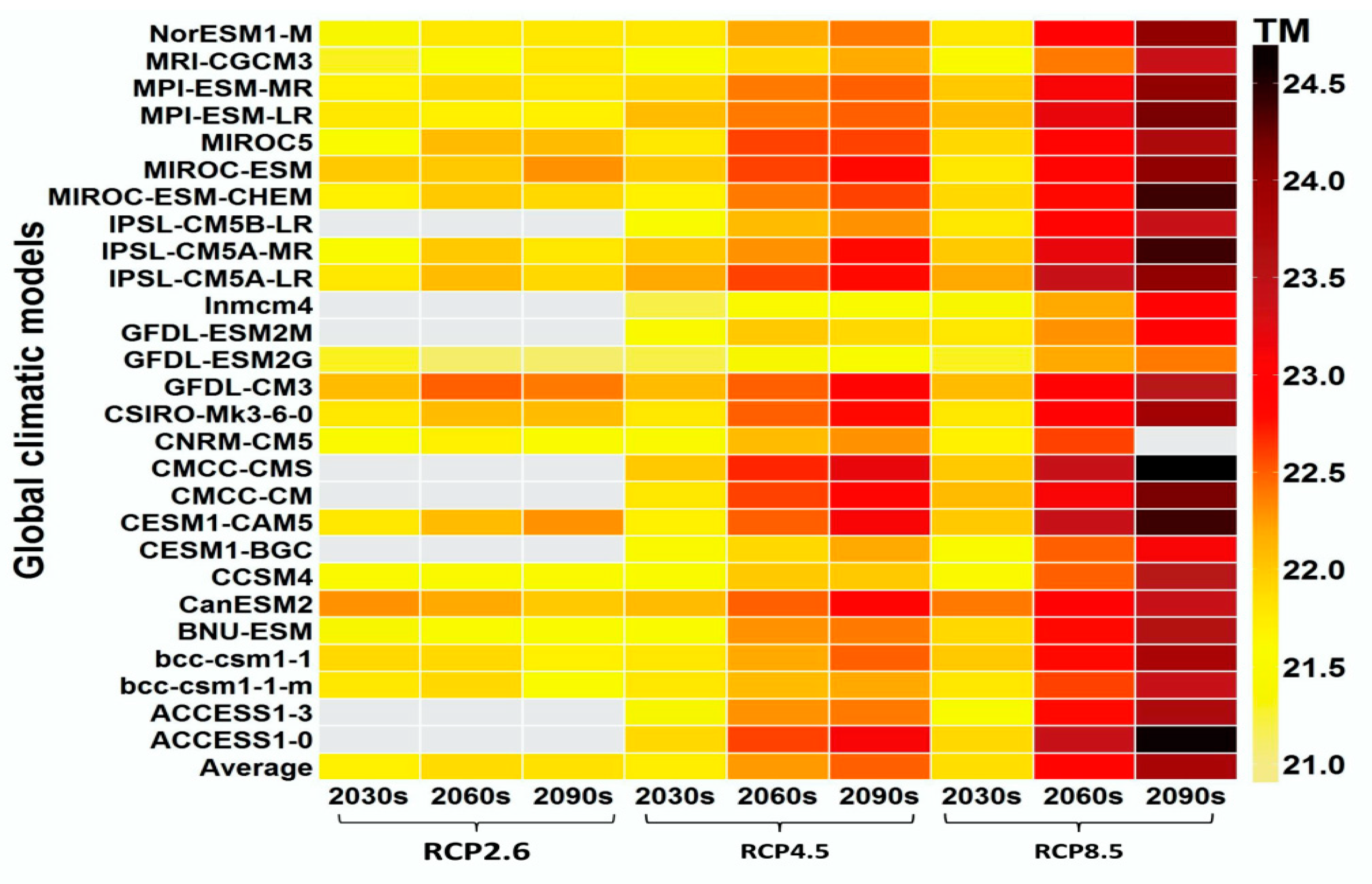
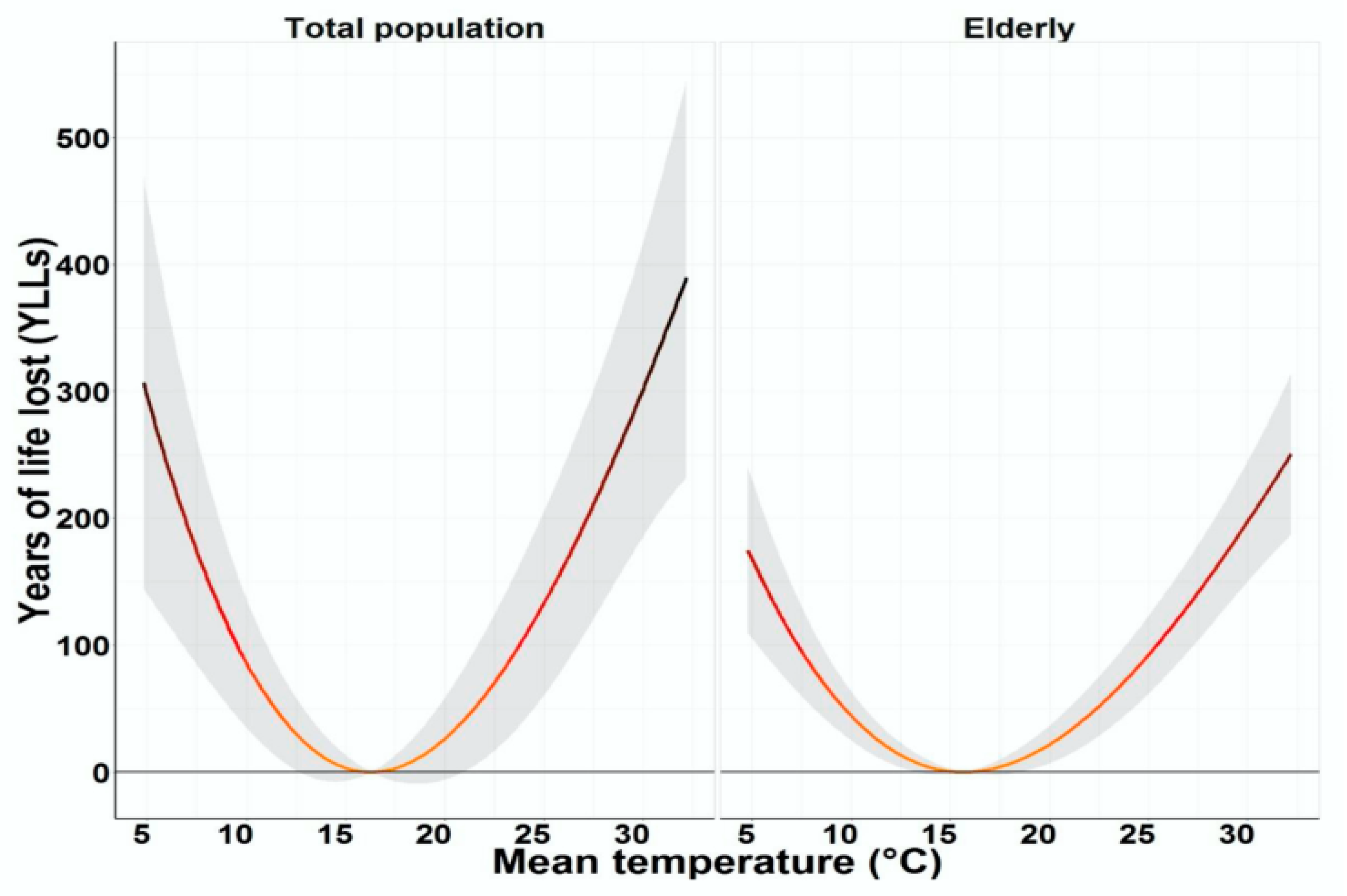
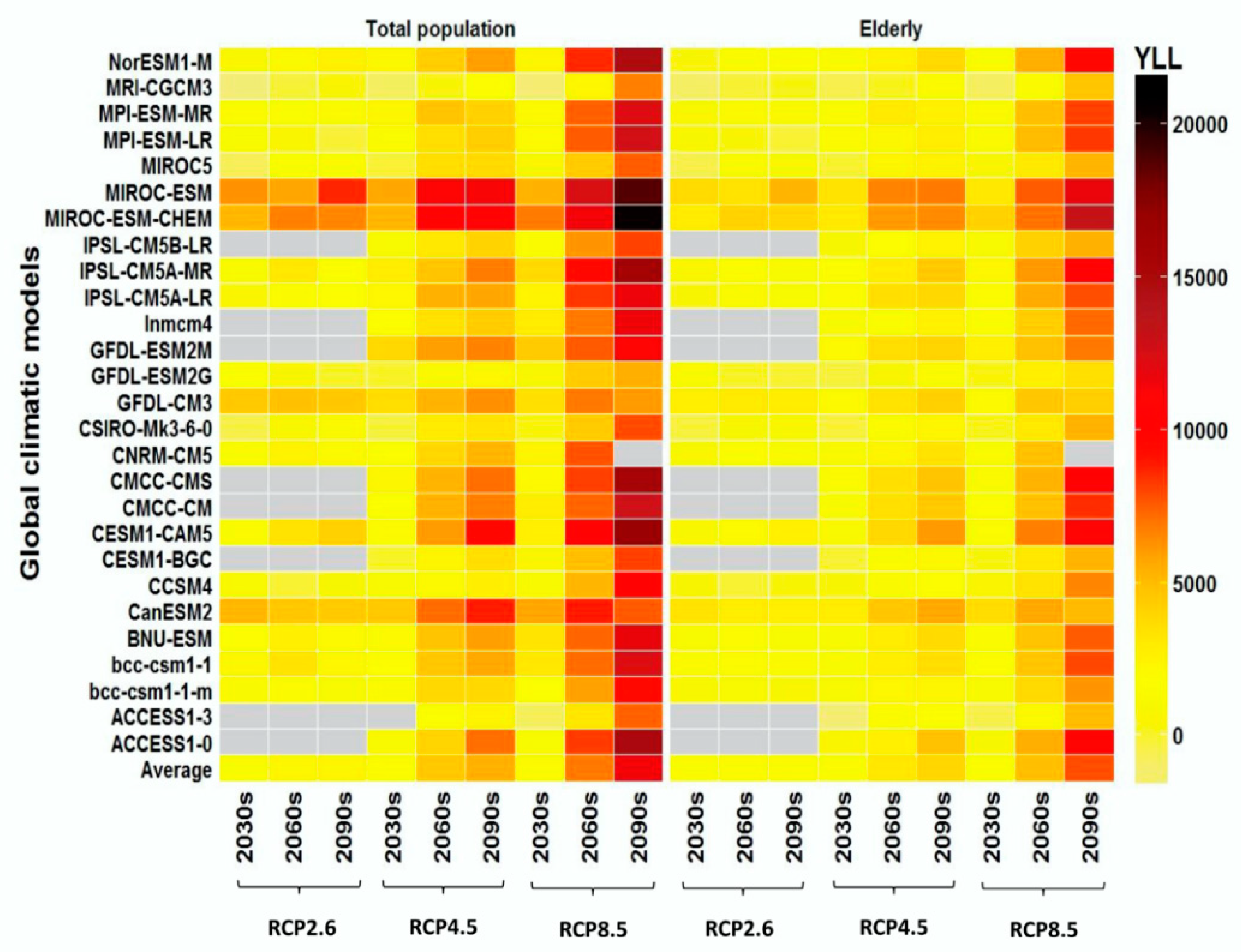
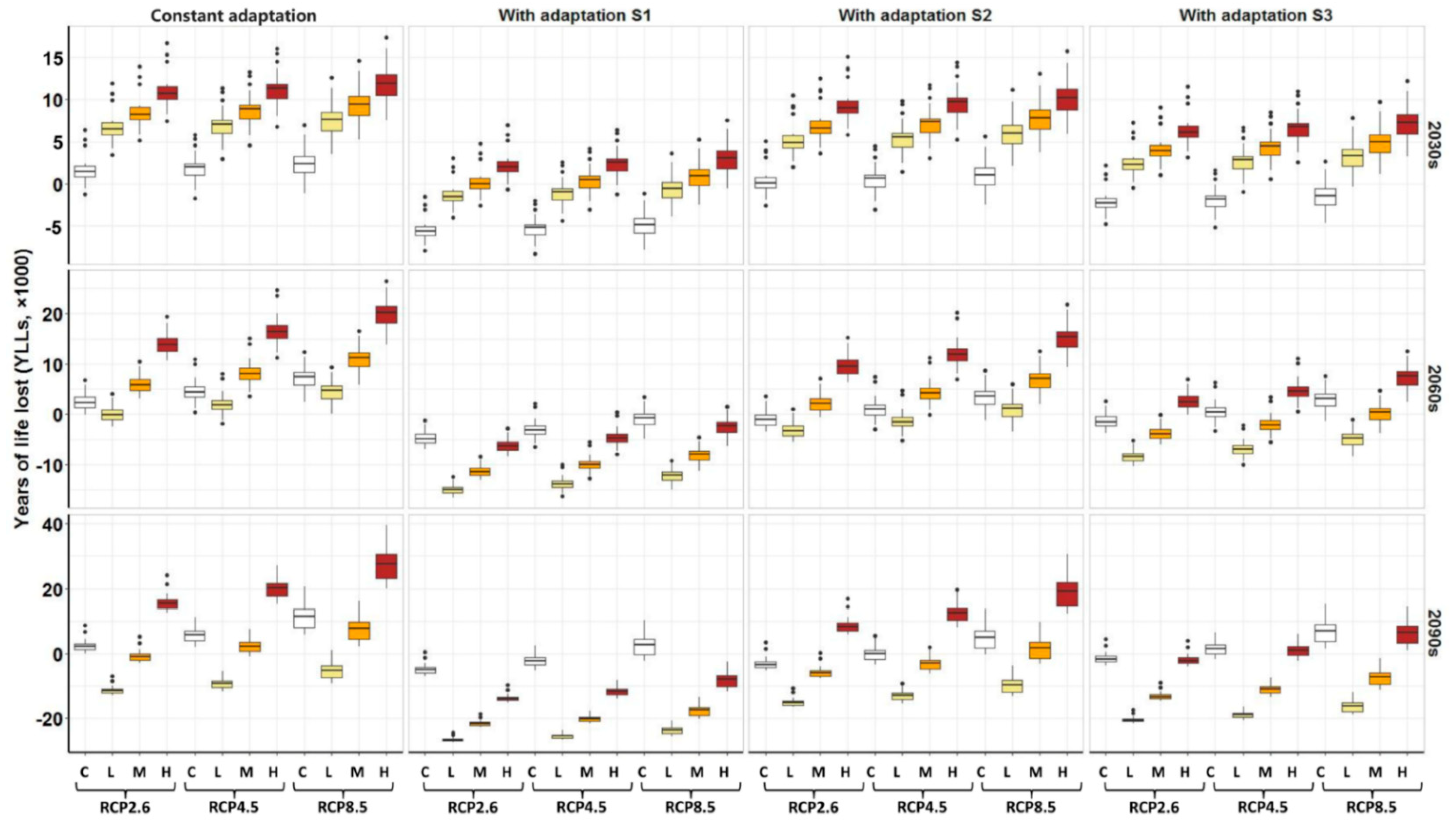
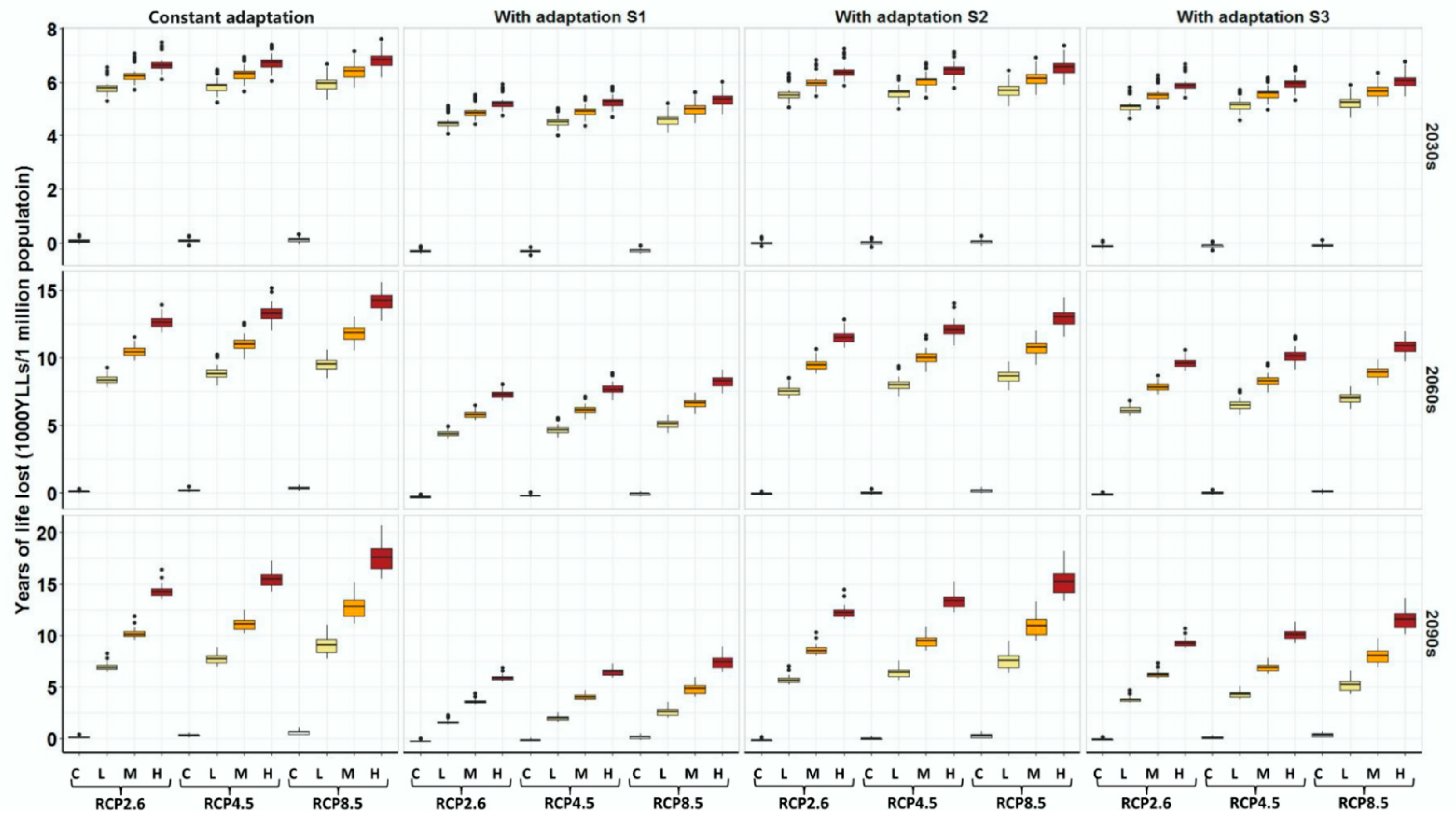
| Variables | Mean | Min | 25th | 75th | Max |
|---|---|---|---|---|---|
| Total YLLs per day | 2408.7 | 982.7 | 2035.2 | 2716.5 | 4171.6 |
| Gender | |||||
| Males | 1455.1 | 522.5 | 1208.8 | 1666.4 | 2652.7 |
| Females | 953.5 | 360.2 | 785.2 | 1095.1 | 1982.9 |
| Age groups | |||||
| <65 years | 1486.6 | 588.8 | 1206.9 | 1712.0 | 2987.0 |
| ≥65 years | 922.1 | 355.0 | 766.4 | 1066.1 | 1731.8 |
| Mean temperature (°C) | 21.9 | 4.8 | 17.3 | 27.2 | 32.2 |
| Wind speed (m/s) | 2.3 | 0.3 | 1.5 | 2.7 | 9.5 |
| Relative humidity (%) | 77.6 | 30.0 | 71.0 | 85.0 | 100.0 |
| Mean temperature (°C) during 1980s | 22.0 | 3.9 | 16.8 | 27.3 | 32.7 |
| SO2 (μg/m3) | 22.2 | 2.0 | 13.1 | 27.7 | 106.5 |
| NO2 (μg/m3) | 44.9 | 9.8 | 29.5 | 54.5 | 345.8 |
| PM10 (μg/m3) | 68.9 | 9.6 | 44.1 | 87.0 | 419.8 |
© 2019 by the authors. Licensee MDPI, Basel, Switzerland. This article is an open access article distributed under the terms and conditions of the Creative Commons Attribution (CC BY) license (http://creativecommons.org/licenses/by/4.0/).
Share and Cite
Liu, T.; Ren, Z.; Zhang, Y.; Feng, B.; Lin, H.; Xiao, J.; Zeng, W.; Li, X.; Li, Z.; Rutherford, S.; et al. Modification Effects of Population Expansion, Ageing, and Adaptation on Heat-Related Mortality Risks Under Different Climate Change Scenarios in Guangzhou, China. Int. J. Environ. Res. Public Health 2019, 16, 376. https://doi.org/10.3390/ijerph16030376
Liu T, Ren Z, Zhang Y, Feng B, Lin H, Xiao J, Zeng W, Li X, Li Z, Rutherford S, et al. Modification Effects of Population Expansion, Ageing, and Adaptation on Heat-Related Mortality Risks Under Different Climate Change Scenarios in Guangzhou, China. International Journal of Environmental Research and Public Health. 2019; 16(3):376. https://doi.org/10.3390/ijerph16030376
Chicago/Turabian StyleLiu, Tao, Zhoupeng Ren, Yonghui Zhang, Baixiang Feng, Hualiang Lin, Jianpeng Xiao, Weilin Zeng, Xing Li, Zhihao Li, Shannon Rutherford, and et al. 2019. "Modification Effects of Population Expansion, Ageing, and Adaptation on Heat-Related Mortality Risks Under Different Climate Change Scenarios in Guangzhou, China" International Journal of Environmental Research and Public Health 16, no. 3: 376. https://doi.org/10.3390/ijerph16030376
APA StyleLiu, T., Ren, Z., Zhang, Y., Feng, B., Lin, H., Xiao, J., Zeng, W., Li, X., Li, Z., Rutherford, S., Xu, Y., Lin, S., Nasca, P. C., Du, Y., Wang, J., Huang, C., Jia, P., & Ma, W. (2019). Modification Effects of Population Expansion, Ageing, and Adaptation on Heat-Related Mortality Risks Under Different Climate Change Scenarios in Guangzhou, China. International Journal of Environmental Research and Public Health, 16(3), 376. https://doi.org/10.3390/ijerph16030376










